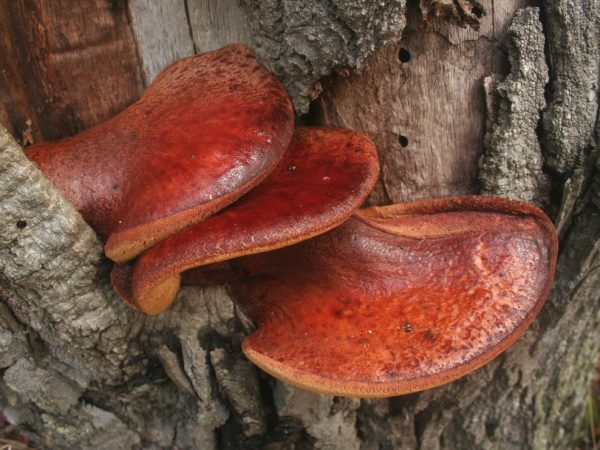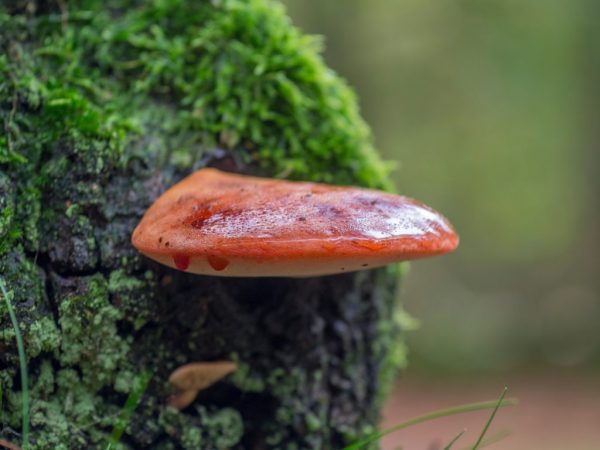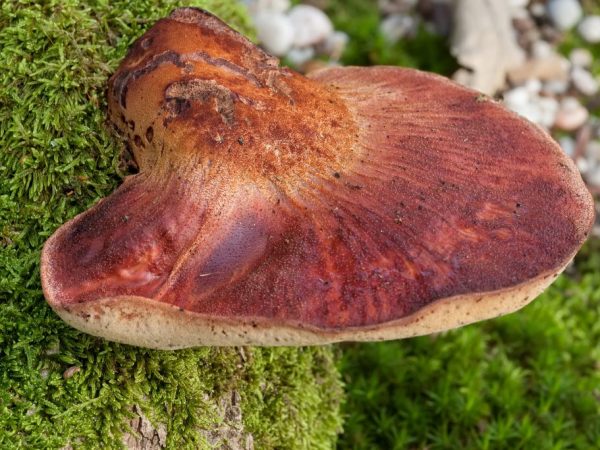Description of the fungus hepatica vulgaris
The common liverwort mushroom got its name for its similarity to the liver of an animal. It has peculiar streaks and red sap. Found on old oaks, fresh stumps, loves chestnuts. It grows separately from the second half of July, until frosts begin. It prefers a warm climate, although it is also found in northern latitudes.

Description of the fungus hepatica vulgaris
Characteristics of the fungus
Other names for the variety are mother-in-law's tongue, hepatic tinder fungus, common liverwort. It belongs to the group of polypores, the Fistulin family, or Liverwort. Fruit bodies are annual.
Hat:
- spatulate or tongue-shaped, elongated;
- reddish-brown color;
- single or accrete (2-3 pcs.);
- below there is not a lamellar, but a tubular porous layer, represented by short small tubes, at first yellowish, then brownish-red.
Leg:
- false;
- short;
- often lateral;
- thick;
- one color with a hat;
- fibrous at the base.

The liverwort belongs to the group of polypores, the Fistulin family.
The cloth:
- thick;
- radial fibrous;
- elastic;
- pink tint;
- juicy;
- fleshy;
- with red veins (marble cut);
- the taste is very sour.
Hymenophore:
- yellow or beige;
- with small tubes;
- turns red when touched.
Irina Selyutina (Biologist):
The liverwort hymenophore has a peculiar and unique structure: although it consists of tubules, each of them is independent, because does not grow together with adjacent walls, as a result of which they are easily separated. In the early stages of development of the fruiting body, the hymenophore layer is practically indistinguishable with the naked eye, but then its thickness as it grows reaches 1-1.5 cm.The pores are large enough and there are 2-3 pieces of them per 1 mm of the surface.
The fruiting body can also be sessile. The sizes are large. According to the description, the length is 30-40 cm, the thickness is 6 cm, and the weight is up to 15 kg. At the initial stage of growth, it has an incomprehensible shape (in the form of a sludge of resin), which becomes more expressive over time. Spores 4.5 × 5 μm, almost round. The taste is delicate, the smell is weak, fruity.
The liverwort usually lives on live old oaks or edible chestnuts, as a rule, closer to the base of the trunk.
Beneficial features
The liver mushroom contains a large amount of vitamin C. 100 g contains the daily norm of ascorbic acid. It also includes:
- carbohydrates;
- proteins;
- minerals;
- vitamins D, PP;
- phosphorus;
- water.
Contraindications
The liver fungus contains, like other representatives of the kingdom, chitin in the cell walls. For this reason, the liverworm is not recommended for children under 7 years of age. It is forbidden to use the mushroom for pregnant and lactating women.
Contraindications also include gout and diseases of the stomach, intestines, kidneys and liver.

Liver mushroom contains high amounts of vitamin C
Application
Young specimens are edible and belong to the 4th flavor category. Eat them until the pulp is stiff.
In medicine
Mother-in-law's tongue is used in fungotherapy - it has a beneficial effect on the body in case of cancer. But there is no scientific evidence for this.
Thanks to the content of a polysaccharide called lanophil, the liver activates the secretion of enzymes that have the ability to break down glucose and fats. They contribute to the normalization of metabolism in the body.
In cooking
The liver mushroom is used only fresh. Fruit bodies contain a lot of acid, with the help of which they protect themselves from the tannins found in the wood of the tree. To remove it, the harvested crop must be soaked in salted water. The liquid is periodically drained and a new one is poured. After that, the mucus is cleaned off and hard fibers are removed from the leg.
The liver mushroom is fried in a pan or on the grill, having previously boiled for 15-20 minutes. It is added to various salads dressed with olive oil. Cutlets are also prepared from the liver tinder fungus: the boiled fruit bodies are ground, flour and egg, spices are added and fried.

The mushroom is used in cooking and medicine
Growing methods
The mycelium of the liverwort fungus is sold on oak sticks, which, after purchase, are inserted into a log or stump. To do this, holes of the corresponding diameter are drilled in them. If the block is too long, the remainder is cut off and inserted into another recess. Also, mushroom sticks are inserted into holes of natural origin. Sawed or live wood (dying plants) is used for infection.
Irina Selyutina (Biologist):
Indeed, when populating the mycelium of the liver fungus, it is recommended to use not only drilled holes, but also holes of natural origin - the main thing is that they fit in size. These can be the results of the "activity" of a woodpecker, or arising from the development of mistletoe and flower garden.
It is also important that the wood is from deciduous trees and not rotten or moldy. It may have lain for several years, the main thing is its compliance with all the characteristics necessary for growing this species.
The dry material should be moistened before using the sticks:
- chocks - soaked for 2-3 days in water;
- stumps - doused 3-5 times a day for a week.
An oak bar is also kept in water for 1.5-2 hours.
The area for placing the deck must be in a shaded and humid place. Basement, cellar, garage, barn are also suitable for growing. Fruiting begins at a temperature of at least 8 ° C after 3-7 months (sometimes the period of development is delayed up to a year). The later the liverwort appears, the longer the mycelium will bear fruit. For the winter, the bases for growing are left outside or brought indoors. Up to 1 kg of yield is obtained from one stick.
Conclusion
The liver fungus is a rare species. On the one hand, it is a parasite that destroys wood, causing brown rot of the core, and on the other, a valuable product.
There are no similar species in the forest. Due to its color of mother-in-law, the tongue is almost impossible to confuse with other mushrooms. When prepared correctly, it will delight you with good taste.



